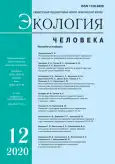Self-perceived health, availability of medical care and health attitudes among rural population in Russia
- Authors: Blinova T.V.1, Vyalshina A.A.1, Rusanovskiy V.A.2
-
Affiliations:
- Institute of Agrarian Problems of the Russian Academy of Sciences
- Yuri Gagarin State Technical University of Saratov
- Issue: Vol 27, No 12 (2020)
- Pages: 52-58
- Section: Articles
- URL: https://journals.rcsi.science/1728-0869/article/view/57067
- DOI: https://doi.org/10.33396/1728-0869-2020-12-52-58
- ID: 57067
Cite item
Full Text
Abstract
Keywords
Full Text
##article.viewOnOriginalSite##About the authors
T. V. Blinova
Institute of Agrarian Problems of the Russian Academy of Sciences
Email: ruandre@mail.ru
доктор экономических наук, профессор, главный научный сотрудник лаборатории социального развития агропромышленного комплекса и сельских территорий Saratov
A. A. Vyalshina
Institute of Agrarian Problems of the Russian Academy of SciencesSaratov
V. A. Rusanovskiy
Yuri Gagarin State Technical University of SaratovSaratov, Russia
References
- Белова Н. И. Сельское здравоохранение: состояние, тенденции и проблемы // Социологические исследования. 2017. № 3. С. 97-105.
- Блинова Т. В. Демографические угрозы и ограничения развития сельских территорий России // Вестник Саратовского государственного социально-экономического университета. 2018. № 2. С. 14-19.
- Богачёв А. И., Полухина М. Г., Студенникова Н. С. Обеспеченность услугами здравоохранения сельских жителей Центральной России // Национальные интересы: приоритеты и безопасность. 2016. Т. 12. Вып. 7. С. 166-177.
- Выборочное наблюдение качества и доступности услуг в сферах образования, здравоохранения и социального обслуживания, содействия занятости в 2017 г. Росстат: 2017. URL: https://rosstat.gov.ru/free_doc/new_site/quality17/ index.html (дата обращения: 01.02.2020).
- Вяльшина А. А. Влияние уровня образования на состояние здоровья сельского населения. Социальные аспекты здоровья населения. 2020. № 66 (1). С. 6. doi: 10.21045/2071-5021-2020 -66-1-6.
- Доклад на комиссии Минздрава РФ по мониторингу достижения целевых показателей социально-экономического развития. URL: http://www.rosminzdrav.ru/news /minzdravrossii (дата обращения: 01.02.2020).
- Карпикова И. С. Качество и доступность медицинских услуг: мнение населения и специалистов сферы здравоохранения // Социологические исследования. 2015. № 6. С. 53-57.
- Кислицына О. А. Факторы, оказывающие влияние на удовлетворенность россиян системой здравоохранения. Социальные аспекты здоровья населения. 2020. № 66 (2). DOI: 10.21045/ 2071-50212020-66-2-8.
- Кочкина Н. Н., Красильникова М. Д., Шишкин С. В. Доступность и качество медицинской помощи в оценках населения. Препринт WP8/2015/03. НИУ Высшая школа экономики. 2015. 56 с.
- Миронова А. А., Наркевич А. Н., Виноградов К. А., Курбанисмаилов Р. Б., Гржибовский А. М. Методика оценки нагрузки смертности от различных причин на ожидаемую продолжительность жизни // Экология человека. 2020. № 5. С. 57-64.
- Россия в цифрах. 2019. Крат. стат. сб./ Росстат. М., 2019.
- Чащин В. П., Аскаров Р. А., Лакман И. А., Аскарова З. Ф. Интегральная оценка влияния социально-экономических, экологических факторов на общую смертность населения // Экология человека. 2020. № 4. С. 4-11. doi: 10.33396/1728-0869 -2020-4-4-11.
- Blinova T., Bylina S., Rusanovskiy V. Factors Affecting the Life Expectancy at Birth of the Rural Population in Russia // Ponte. 2020. N 76 (1). P. 9-18. DOI: 10.21506/j. ponte. 2020.1.2.
- Footman K., Roberts B., Mills A., Richardson E., McKee M. Public satisfaction as a measure of health system performance: A study of nine countries in the former Soviet Union // Health Policy. 2013. N 112 (1). P. 62-69.
- Lahooti H., RodK. and Kangarlu A. Healthcare Delivery to the rural area in Iran // American Journal of Biomedical Sciences & Research. 2019. N 3 (5). P. 426-430. DOI: 10. 34297/AJBSR.2019. 03.000709.
- Tashobya C. K., da Silveira V. C., Ssengooba F. et al. Health systems performance assessment in low-income countries: learning from international experiences // Globalization and Health. 2014. N 10 (5). DOI: 10.1 186/1744-8603-10-5.
- Wang L., Wang Z., Ma Q. et al. The development and reform of public health in China from 1949 to 2019 // Global Health. 2019. N 15 (45). doi: 10.1186/s12992-019-04 86-6.
- Zhai S., Wang P., Wang A. et al. A study on satisfaction with publicly financed health services in China // Global Health. 2017. N 13 (67). doi: 10.1186/s12992-017-0292-y.
Supplementary files







